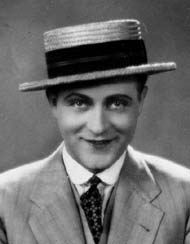
Drei Unteroffiziere is a 1939 German film.

Willy Fritsch was a German theater and film actor, a popular leading man and character actor from the silent-film era to the early 1960s.

Willy Birgel, born Wilhelm Maria Birgel, was a German theatre and film actor.

Attack on Baku is a 1942 German thriller film directed by Fritz Kirchhoff and starring Willy Fritsch, René Deltgen, and Fritz Kampers. The film was intended as anti-British propaganda during the Second World War. It is noted for its set designs by Otto Hunte, who showed a fascination for modern technology in his depiction of the oil town. The film was shot on location in German-allied Romania, and at Babelsberg Studio in Berlin.

Faded Melody is a 1938 German drama film directed by Viktor Tourjansky and starring Brigitte Horney, Willy Birgel and Carl Raddatz. The film was made by Germany's largest studio of the era UFA. It was shot at the Babelsberg Studios in Potsdam and on location in French Algeria, New York City and Berlin. The film's sets were designed by the art directors Hermann Asmus and Max Mellin. It premiered at Berlin's Gloria-Palast.

Target in the Clouds is a 1939 German drama film directed by Wolfgang Liebeneiner and starring Albert Matterstock, Leny Marenbach and Brigitte Horney. It was based on a novel by Hans Rabl. The film portrays the struggles of the fictional German aviation pioneer Walter von Suhr, an officer in the pre-First World War German army who saw the potential for military aircraft.

The Girl from Barnhelm is a 1940 German historical comedy film directed by Hans Schweikart and starring Käthe Gold, Ewald Balser and Fita Benkhoff. It is an adaptation of the 1767 play Minna von Barnhelm by Gotthold Ephraim Lessing.

Ride to Freedom is a 1937 German historical war film directed by Karl Hartl and starring Willy Birgel, Viktor Staal and Hansi Knoteck. The film is set in the 1830s during Poland's November Uprising against the Russian Empire. It portrays the rehabilitation of a Polish cavalry officer whose initial reluctance to engage the enemy leads to the death of his comrades, but later dies fighting bravely.

Maria Ilona is a 1939 German historical drama film directed by Géza von Bolváry and starring Paula Wessely, Willy Birgel, and Paul Hörbiger. The film is set in Austria during the reign of Ferdinand I. It is an adaptation of Oswald Richter-Tersik's novel Ilona Beck.
Diesel is a 1942 German biographical film directed by Gerhard Lamprecht and starring Willy Birgel, Hilde Weissner, and Paul Wegener. It portrays the life of Rudolf Diesel, the German inventor of the diesel engine. It was one of a series of prestigious biopics made in Nazi Germany portraying genius inventors or artists struggling against the societies in which they live. The film was based on a biography by Eugen Diesel, one of Diesel's children.

Riding for Germany is a 1941 German drama film directed by Arthur Maria Rabenalt and starring Willy Birgel, Gertrud Eysoldt and Gerhild Weber. A German cavalry officer, badly injured during the First World War, emerges as a leading competitor in post-war equestrian events.

A Salzburg Comedy or Little Border Traffic is a 1943 German comedy film directed by Hans Deppe and starring Willy Fritsch, Hertha Feiler and Heinz Salfner. Erich Kästner wrote the screenplay based on one of his own novels. As he had been blacklisted by the Nazi Party, he used the pseudonym Berhold Bürger. The novel was again adapted for the 1957 film Salzburg Stories.

Enemies is a 1940 German drama film directed by Viktor Tourjansky and starring Brigitte Horney, Willy Birgel and Reinhold Lütjohann. The film was a Nazi propaganda work, attacking Poland which Germany had invaded the year before. The film's sets were designed by Herbert Hochreiter, Alfred Metscher and Julius von Borsody.

Black Roses is a 1935 German historical drama film directed by Paul Martin and starring Lilian Harvey, Willy Fritsch and Willy Birgel. A separate English-language version Black Roses was also made with Harvey reprising her role opposite Esmond Knight. She also starred in a French version. The film was Harvey's comeback in German cinema, following her attempts to find enduring success in Hollywood and then in British films. One source suggested that Harvey paid for the English version of the film to be made out of her own money, as she still hoped to break into the English-speaking market.

In der Heimat, da gibt's ein Wiedersehn! is a 1926 German silent film directed by Leo Mittler and Reinhold Schünzel. It shares its name with a popular song title.

One Too Many on Board is a 1935 German drama film directed by Gerhard Lamprecht and starring Lída Baarová, Albrecht Schoenhals and René Deltgen. It was shot at the Babelsberg Studios in Berlin. The film's sets were designed by the art directors Otto Erdmann and Hans Sohnle. Some scenes were shot on location in Hamburg. A separate French-language version was also released.

Secret Code LB 17 is a 1938 German thriller film directed by Victor Tourjansky and starring Willy Birgel, Hilde Weissner and Bernhard Minetti. It was made at the Babelsberg Studios outside Berlin. The film's sets were designed by the art directors Karl Böhm and Erich Czerwonski.

A Heart Returns Home is a 1956 West German musical drama film directed by Eugen York and starring Maximilian Schell, Willy Birgel and Maria Holst. It was shot at the Wandsbek Studios in Hamburg and on location in Celle. The film's sets were designed by the art directors Albrecht Becker and Herbert Kirchhoff.

The Governor is a 1939 German drama film directed by Viktor Tourjansky and starring Brigitte Horney, Willy Birgel and Hannelore Schroth. It is based on the play Die Fahne by Emmerich Groh. It was shot at the Babelsberg and Tempelhof Studios in Berlin and on location in East Prussia. The film's sets were designed by the art director Max Mellin. It was produced on a budget of 715,000 Reichsmarks.

















